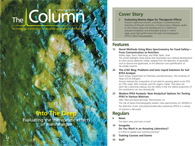Postnova Announces Viral Collaboration with University of Helsinki
Postnova Analytics has announced a joint collaboration with the Department of Biosciences at the University of Helsinki in Finland, to use AF4 for the purification of halophilic viruses.
Postnova Analytics (Landsberg am Lech, Germany) has announced a joint collaboration with the Department of Biosciences at the University of Helsinki in Finland, to use asymmetrical flow fieldâflow fractionation (AF4) for the purification of halophilic viruses.
Viruses that persist in extreme environments, such as high salinity or high temperatures, are of particular interest to researchers because of their unique adaptations for survival, and one of the main challenges involved in studying these viruses has been to identify an efficient separation technique-in particular, a separation technique that both purifies and maintains the infectious nature of the viruses.
A recent publication to come out of the collaboration details the technique developed to purify and study extremophilic viruses (1). Four viral morphotypes were successfully purified with high virus recoveries and purities comparable to those of multistep ultracentrifugation purification methods. The paper also explains how to use AF4 as a rapid monitoring tool for virus production in slowly growing host cells living in extreme conditions.
For more information, please visit www.postnova.com
Reference
- K. Eskelin et al., Extremophiles21, 1119 (2017).




















Removing Double-Stranded RNA Impurities Using Chromatography
April 8th 2025Researchers from Agency for Science, Technology and Research in Singapore recently published a review article exploring how chromatography can be used to remove double-stranded RNA impurities during mRNA therapeutics production.
The Effect of Time and Tide On PFAS Concentrations in Estuaries
April 8th 2025Oliver Jones and Navneet Singh from RMIT University, Melbourne, Australia discuss a recent study they conducted to investigate the relationship between tidal cycles and PFAS concentrations in estuarine systems, and offer practical advice on the sample preparation and LC–MS/MS techniques they used to achieve the best results.
Removing Double-Stranded RNA Impurities Using Chromatography
April 8th 2025Researchers from Agency for Science, Technology and Research in Singapore recently published a review article exploring how chromatography can be used to remove double-stranded RNA impurities during mRNA therapeutics production.
The Effect of Time and Tide On PFAS Concentrations in Estuaries
April 8th 2025Oliver Jones and Navneet Singh from RMIT University, Melbourne, Australia discuss a recent study they conducted to investigate the relationship between tidal cycles and PFAS concentrations in estuarine systems, and offer practical advice on the sample preparation and LC–MS/MS techniques they used to achieve the best results.
